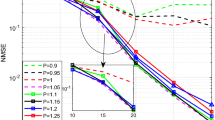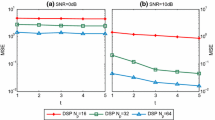Abstract
Channel state information is essential for base station (BS) to fully exploit the merits of massive multiple input multiple output, which consumes large amount of pilot overhead attributed to tremendous number of BS antennas. Accordingly, huge computational complexity of correlation operation tends to be an obstacle for the implementation of compressive channel estimation algorithms, especially for greedy algorithms. In this paper, pilot overhead problem lightens by exploiting common support property due to the close space of BS antenna array. Furthermore, a low complexity correlation algorithm is proposed for each iteration of greedy algorithm, which exploits the inherent of pilot distribution and sensing matrix composed of pilot sequence. Complexity of proposed algorithm related to pilot distribution is also investigated. Performance analysis and simulation results prove that the proposed algorithm maintains the same performance, while achieves much less computational complexity than the original greedy algorithm.










Similar content being viewed by others
Change history
07 June 2018
The original version of this article unfortunately contained a mistake in “Algorithm 1” under Section 3. The ellipsis in Algorithm 1 appears as alpha “L” in the published article
References
E. Larsson, O. Edfors, F. Tufvesson, et al., Massive MIMO for next generation wireless systems, IEEE Communications Magazine, Vol. 52, No. 2, pp. 186–195, 2014.
L. Lu, G. Y. Li, A. L. Swindlehurst, et al., An overview of massive MIMO: benefits and challenges, IEEE Journal of Selected Topics in Signal Processing, Vol. 8, No. 5, pp. 742–758, 2014.
B. Amin, B. Mansoor, S. J. Nawaz, et al., Compressed sensing of sparse multipath MIMO channels with superimposed training sequence, Wireless Personal Communications, 2016. https://doi.org/10.1007/s11277-016-3778-7.
W. U. Bajwa, J. Haupt, A. M. Sayeed, et al., Compressed channel sensing : a new approach to estimating sparse multipath channels, Proceedings of the IEEE, Vol. 98, No. 6, pp. 1058–1076, 2010.
Y. Barbotin, A. Hormati, S. Rangan, et al., Estimation of Sparse MIMO channels with common support, Communications IEEE Transactions on, Vol. 60, No. 12, pp. 3705–3716, 2012.
F. Yu, D. Li, Q. Guo, et al., Block-FFT based OMP for compressed channel estimation in underwater acoustic communications, Communications Letters IEEE, Vol. 19, No. 11, pp. 1937–1940, 2015.
C. Qi, G. Yue, L. Wu, et al., Pilot design schemes for sparse channel estimation in OFDM systems, IEEE Transactions on Vehicular Technology, Vol. 64, No. 4, pp. 1493–1505, 2015.
R. Mohammadian, A. Amini and B. H. Khalaj, Deterministic pilot design for sparse channel estimation in MISO/multi-user OFDM systems, IEEE Transactions on Wireless Communications, Vol. 16, No. 1, pp. 129–140, 2017.
W. Hou and C. W. Lim, Structured compressive channel estimation for large-scale MISO-OFDM Systems, IEEE Communications Letters, Vol. 18, No. 5, pp. 765–768, 2014.
Z. Gao, L. Dai, W. Dai, et al., Structured compressive sensing-based spatio-temporal joint channel estimation for FDD massive MIMO, IEEE Transactions on Communications, Vol. 64, No. 2, pp. 601–617, 2016.
J. Choi, B. Shim and S. Chang, Downlink pilot reduction for massive MIMO systems via compressed sensing, IEEE Communications Letters, Vol. 19, No. 11, p. 1, 2015.
Y. H. Nam, Y. Akimoto, Y. Kim, et al., Evolution of reference signals for LTE-advanced systems, IEEE Communications Magazine, Vol. 50, No. 50, pp. 132–138, 2012.
W. Ding, F. Yang, S. Liu, et al., Non-orthogonal time-frequency training sequence based CSI acquisition for MIMO systems, IEEE Transactions on Vehicular Technology, Vol. 65, No. 7, pp. 5714–5719, 2015.
Y. Eldar and G. Kutyniok, Compressed Sensing: Theory and Applications, Cambridge University PressCambridge, 2012.
Acknowledgements
The authors wish to thank reviewers. This work was supported by the Fundamental Research Funds for the Center Universities (Grant No. HIT.MKSTISP.2016 13).
Author information
Authors and Affiliations
Corresponding author
Additional information
The original version of this article was revised: In Algorithm 1, the alpha "L" has been corrected as ellipsis.
Rights and permissions
About this article
Cite this article
Zhang, R., Zhao, H., Shan, C. et al. A Low Complexity Correlation Algorithm for Compressive Channel Estimation in Massive MIMO System. Int J Wireless Inf Networks 25, 371–381 (2018). https://doi.org/10.1007/s10776-018-0398-z
Received:
Accepted:
Published:
Issue Date:
DOI: https://doi.org/10.1007/s10776-018-0398-z




